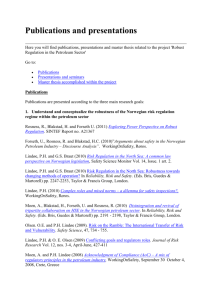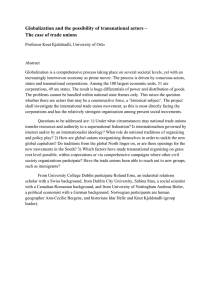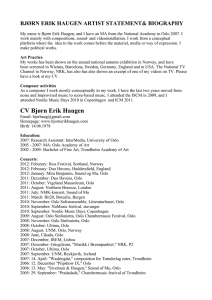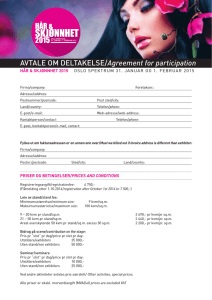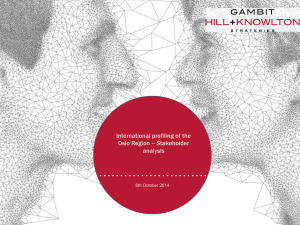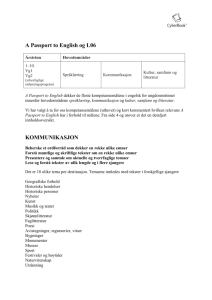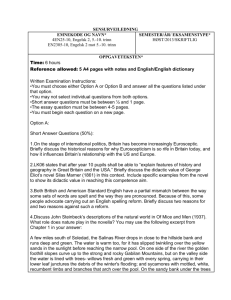Norway
advertisement
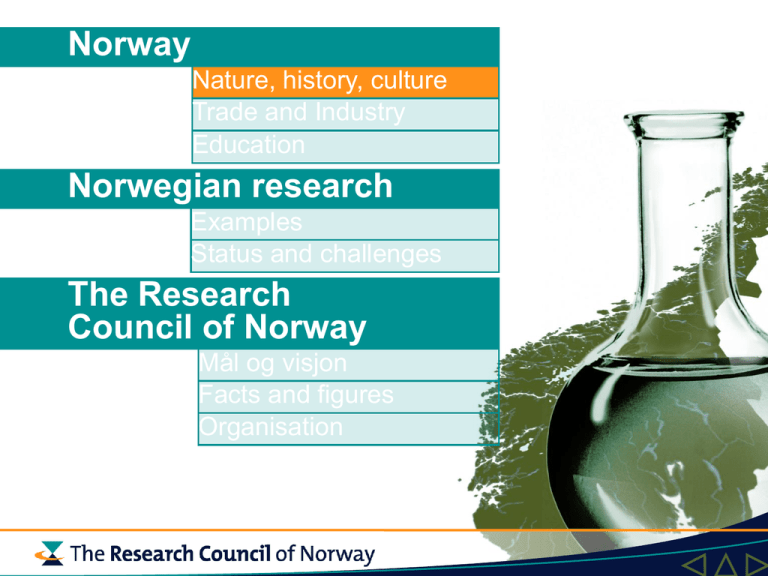
Norway Nature, history, culture Trade and Industry Education Norwegian research Examples Status and challenges The Research Council of Norway Mål og visjon Facts and figures Organisation Norway Nature, history, culture Trade and Industry Norwegian research Examples Status and challenges The Research Council of Norway Mål og visjon Facts and figures Organisation Et lite land Antall innbyggere: 4,5 millioner Areal: 307.860 km2 A cold country… A cold country… men mye varmere enn andre områder så langt mot nord, på grunn av Golfstrømmen Only 3 % arable land 70 % is high plateaus and rugged mountains A long coastline and 50.000 islands Norway: The traditional view Norge er også et moderne samfunn med høyt utdannet befolkning og et dynamisk næringsliv Historie Bebodd siden slutten av istiden (10 000 år siden) Vikingtid 800-1200 Union med Danmark i perioden 1200-1814 Egen grunnlov i 1814 Union med Sverige 1814-1905 Selvstendig i 1905 Historie Nøytral, men okkupert av NaziTyskland i 1940 NATO-medlem 1949 Nei til EU i 1972 og 1994 In the course of a century, Norway has evolved from a quiet agrarian society to a dynamic, high-tech country Kultur Henrik Ibsen Knut Hamsun Sigrid Undset X X Dagens: Jan Kjærstad, Jostein Gaarder Kultur Edvard Munch Gustav Vigeland X X Dagens: Olav Christoffer Jensen, Odd Nerdrum, Per Maning, Marianne Heske… Kultur Edvard Grieg Kirsten Flagstad X X Dagens: Jan Garbarek, Leiv Ove Ansnes, A-ha, Røyksopp Norway Nature, history, culture Trade and Industry Norwegian research Examples Status and challenges The Research Council of Norway Mål og visjon Facts and figures Organisation Industry Norway’s core markets: the Nordic region and Europe Membership in the European Economic Area (EEA) provides full access to the EU Single Market Oil & gas, fisheries, aquaculture, light metals Norway is the world’s second largest oil exporter after Saudi Arabia 4 % of the world´s production of aluminium 14 % of the world´s production of magnesium Verdens nest største fiskeeksportør Leading maritime nation Norway has the world’s fourth largest merchant fleet, with 4,5 % of the world’s total tonnage Norway – a specialized shipbuilder Norway Nature, history, culture Trade and Industry Education Norwegian research Examples Status and challenges The Research Council of Norway Mål og visjon Facts and figures Organisation Education Andel med høy utdannelse: Blant de med høyest andel i Europa X X X X Norway Nature, history, culture Trade and Industry Norwegian research Examples Status and challenges The Research Council of Norway Mål og visjon Facts and figures Organisation 13 Norwegian centres of Excellence Theoretica l Linguistics Quality of Service in Communication Systems Ships and ocean structures Biology of memory Climate Research Centre and perifery in medieval Europe Integrated petroleum research Molecular biology and neuroscience Mathematics for applications Study of Civil wars Physics of geological processe Geohazards Aquaculture protein Center for the Study of Civil War Hvorfor bryter det ut borgerkrig? Borgerkrig er dagens mest dominerende form for krig Ships and Ocean Structures Innovativ drift og konstruksjon av fremtidens skip og marine konstruksjoner Centre for Molecular Biology and Neuroscience DNA-reparasjoner ved nevrologiske sykdommer og aldring av hjernen Bjerknes Centre for Climate Research Kunnskap om fortidens klima, havets rolle i hurtige klimaendringer og betydningen av forandringer i polarstrøkene Forskning som drivkraft i havbruk Produksjonskostnad per kilo laks 100 kroner 80 kroner Hitravaksin e Stormerder Furunkolos e-vaksine ILAvaksine? 60 kroner 40 kroner 20 kroner ? 1975 1980 1985 1990 1995 2000 2005 Forskning som drivkraft i norsk oljeog gassindustri 40 1.000 0 STBODP EKOFISK-feltet: Produksjon 30 0 Forskning har gitt økt produksjon og større reserver! 20 0 101971 0 1976 1981 1986 1991 1996 Mison, et teknologieksempel Samarbeid mellom kreative sivilingeniører, medisinske grunnforskere og kirurger Mison, et teknologieksempel Utstyr for å utføre hjernekirurgi ved hjelp av ultralydveiledet kikkhullsteknikk DNA-merking av olje Opplysninger om oljens opphav blir kodet ved hjelp av syntetiske DNA-molekyler Kaupang – Norges første by Utgravingene viser spor etter en liten by etablert på 700-tallet. 200 år før historikerne trodde Norges byer ble etablert Gullmynter fra Nederland Glassperler fra Midt-Østen og Asia Bronsehest Funnene viser rik kontakt med omverden Norway Nature, history, culture Trade and Industry Norwegian research Examples Status and challenges The Research Council of Norway Mål og visjon Facts and figures Organisation Norwegian R&D efforts 1999: 25 500 R&D man-years 7.300 man-years – higher education sector 7.100 man-years – institute sector 11.000 man-years – industry sector Norway spent NOK 20,5 billion/year on research in 1999 Sources of funding Private sector 10 billion Industry sector 9,5 billion R&D performers Foreign Public sector sources + others 8,5 billion NOK 2 billion Institute sector 5 billion Higher education sector 6 billion Total R&D expenditures in some OECD countries (1981-1999) 4,0 Sweden % of GDP Japan Finland 3,0 USA OECD average 2,0 Denmark Norway 1,0 1981 1991 1999 R&D expenditures financed by industry (1995-1999) 5 % of industry’s gross product Sweden 4 Finland 3 Denmark 2 OECD-average Norway 1 1995 1997 1999 New or improved products as a share of total turnover (1996 (97)) Improved Norway New products Denmark Finland Sweden Ireland % 0 10 20 30 40 Relative citation index 1,3 1,2 Index in overlapping five years periods (1980-2000) Denmark Sweden Finland 1,1 World average 1 Norway 0,9 0,8 1980 1990 2000 R&D expenditures in industry by R&D fields (1999) Other Pharmaceuticals Environmental technology Offshore technology Energy supply/usage Biotechnology Aqua culture Material technology Information and communication technology Main challenges for Norwegian research and innovation Strengthen financing, organisation and quality of research Secure future creation of wealth through a more knowledge intensive industry Strengthen productivity and quality of services in the public sector Strengthen the universities Strengthen the coordination of science policy in and between the ministries Norway Nature, history, culture Trade and Industry Norwegian research Examples Status and challenges The Research Council of Norway Mål og visjon Facts and figures Organisation The Research Council allocates ~30 % of all public sector R&D funding The Private sector 10 billion Foreign sources + others NOK 2 billionNOK Research Council 3.3 billion 57 % 36 % 7% Industry sector R&D performers Institute sector Higher education sector 2001 The Research Council of Norway (1) Semi-autonomous government agency funded by 15 ministries Activities in both basic and applied research in all scientific fields The Research Council of Norway (1) Semi-autonomous government agency funded by 15 ministries Activities in both basic and applied research in all scientific fields Vision: A society that values research-based knowledge as a source of enrichment, learning and innovation A strategic body designed to be An important research adviser to the Norwegian government Identifying research needs Proposing research priorities Norway’s main research funding body Implementing national research policy measures by allocating funds to research programmes and projects A network builder between researchers, funding sources and research users Priorities 2001-2006 Basic science Marine science and technology Information and communication technology Energy and environment Medicine and health Main objectives and strategies 2002–2006 Research of high quality A well-functioning research system Increased research-based value creation and renewal A future-oriented research policy Main objectives and strategies Research of high quality Improved framework conditions More competition and openness Increased interaction Increased concentration Increased internationalisation 2002–2006 Main objectives and strategies 2002–2006 A well-functioning research system More co-operation and mobility Continuous assessment of structure of and co-operation in the research system Make the research profession attractive Main objectives and strategies 2002–2006 Increased research-based value creation and renewal A good balance between developing scientific disciplines and use of competence Further development of the tax incentives and increased funding of industrial R&D More research improving production of services in the public sector Dissemination of research results into society Main objectives and strategies 2002–2006 A future-oriented research policy Greater focus on innovation policy An extended mandate for the Ministry of Education and Research (UFD) Increased internationalisation Norway Nature, history, culture Trade and Industry Norwegian research Examples Status and challenges The Research Council of Norway Mål og visjon Facts and figures Organisation Budget development (1993-2003) 4000 Mill. NOK 3500 3000 2500 2000 1993-NOK 1500 1000 500 0 1993 1995 1997 1999 2001 2003 Funding received from the ministries Total NOK 4.245 million (2003) Administration The Research Fund Miscellaneous ministries 529 Ministry of Education and Research 197 Ministry of 118 Environment Ministry of 221 Agriculture 313 Ministry of Fisheries 235 235 Ministry of Petroleum and energy 1 075 845 Ministry of Trade and Industry Total budget by activities Total NOK 4.245 million (2003) Misc. FuGe Infrastructure Independent projects Programmes Budget by activities (1994 -2003) Mill. NOK 1500 Programmes 1000 Infrastructure 500 Independent projects Misc. 0 1994 FuGe 1996 1998 2000 2002 Norway Nature, history, culture Trade and Industry Norwegian research Examples Status and challenges The Research Council of Norway Mål og visjon Facts and figures Organisation The Research Council of Norway Director General Staff Administration Division of Science International staff Communication Division for Strategic Priorities Division for Innovation Norway Nature, history, culture Trade and Industry Norwegian research Examples Status and challenges The Research Council of Norway Mål og visjon Facts and figures Organisation
